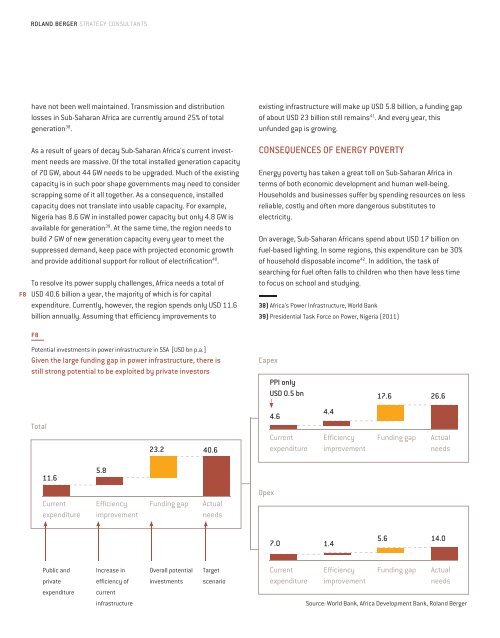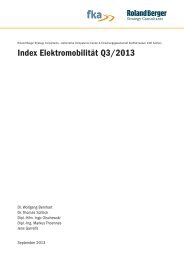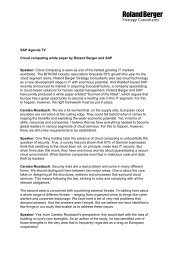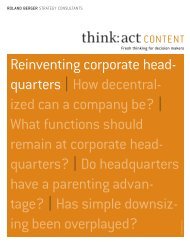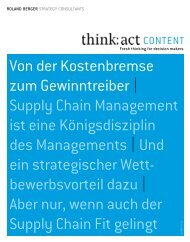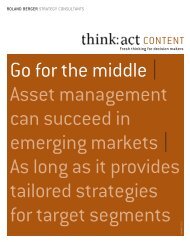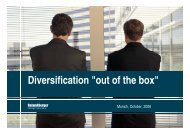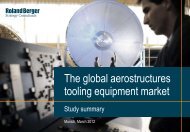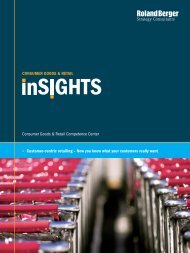think: act STUDY "Inside Africa" - Roland Berger
think: act STUDY "Inside Africa" - Roland Berger
think: act STUDY "Inside Africa" - Roland Berger
Create successful ePaper yourself
Turn your PDF publications into a flip-book with our unique Google optimized e-Paper software.
<strong>Roland</strong> BeRgeR Strategy ConSultantS<br />
f8<br />
have not been well maintained. transmission and distribution<br />
losses in Sub-Saharan africa are currently around 25% of total<br />
generation 38 .<br />
as a result of years of decay Sub-Saharan africa's current investment<br />
needs are massive. of the total installed generation capacity<br />
of 70 gW, about 44 gW needs to be upgraded. Much of the existing<br />
capacity is in such poor shape governments may need to consider<br />
scrapping some of it all together. as a consequence, installed<br />
capacity does not translate into usable capacity. for example,<br />
nigeria has 8.6 gW in installed power capacity but only 4.8 gW is<br />
available for generation 39 . at the same time, the region needs to<br />
build 7 gW of new generation capacity every year to meet the<br />
suppressed demand, keep pace with projected economic growth<br />
and provide additional support for rollout of electrification 40 .<br />
to resolve its power supply challenges, africa needs a total of<br />
uSd 40.6 billion a year, the majority of which is for capital<br />
expenditure. Currently, however, the region spends only uSd 11.6<br />
billion annually. assuming that efficiency improvements to<br />
existing infrastructure will make up uSd 5.8 billion, a funding gap<br />
of about uSd 23 billion still remains 41 . and every year, this<br />
unfunded gap is growing.<br />
conSeQuenceS of eneRgy poveRty<br />
energy poverty has taken a great toll on Sub-Saharan africa in<br />
terms of both economic development and human well-being.<br />
Households and businesses suffer by spending resources on less<br />
reliable, costly and often more dangerous substitutes to<br />
electricity.<br />
on average, Sub-Saharan africans spend about uSd 17 billion on<br />
fuel-based lighting. in some regions, this expenditure can be 30%<br />
of household disposable income 42 . in addition, the task of<br />
searching for fuel often falls to children who then have less time<br />
to focus on school and studying.<br />
38) africa's power infrastructure, World bank<br />
39) presidential task force on power, nigeria (2011)<br />
f8<br />
potential investments in power infrastructure in SSa [uSd bn p.a.]<br />
given the large funding gap in power infrastructure, there is<br />
still strong potential to be exploited by private investors<br />
capex<br />
PPi only<br />
UsD 0.5 bn<br />
17.6<br />
26.6<br />
Total<br />
23.2 40.6<br />
4.6<br />
Current<br />
expenditure<br />
4.4<br />
efficiency<br />
improvement<br />
funding gap<br />
<strong>act</strong>ual<br />
needs<br />
11.6<br />
5.8<br />
Current<br />
expenditure<br />
efficiency<br />
improvement<br />
funding gap<br />
<strong>act</strong>ual<br />
needs<br />
Opex<br />
7.0<br />
1.4<br />
5.6<br />
14.0<br />
public and<br />
private<br />
expenditure<br />
increase in<br />
efficiency of<br />
current<br />
infrastructure<br />
overall potential<br />
investments<br />
target<br />
scenario<br />
Current<br />
expenditure<br />
efficiency<br />
improvement<br />
funding gap<br />
<strong>act</strong>ual<br />
needs<br />
Source: World bank, africa development bank, roland berger


